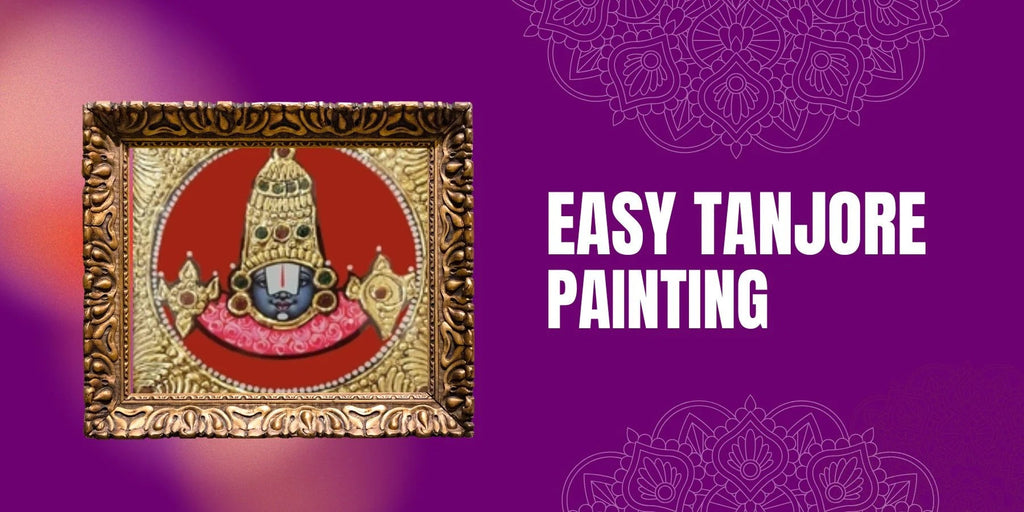The golden gleam of a Tanjore painting never fails to stop hearts. Its embossed details, shimmering gold leaves, and divine motifs breathe life into a wooden panel. To many, it may look like a complex craft locked inside traditional studios of South India, but an easy Tanjore painting is very much possible at home—if one gathers the right materials. You don’t need to be a master artist. What you need is the patience to go for it, the right kit, and an eagerness to play with color and gold. For those who wish to recreate a Tanjore painting elephant or those who wish to experiment with small Tanjore paintings for gifting, this guide reveals the essentials you must have.
Table of Contents
The Base – Where Your Easy Tanjore Painting Begins
Colors and Gold Leaf Work in Small Tanjore Paintings
Brushes, Stones, and Other Decorative Tools
The Base – Where Your Easy Tanjore Painting Begins
Every Tanjore painting begins not with paint but with a base. Traditionally, a wooden plank—usually jackfruit or teak—is used. But for an easy Tanjore painting at home, you can also start with plywood or MDF board.
Here is what you will need:
Wooden base or plywood: Acts as your foundation. Without this, nothing stands.
Cloth (cotton or muslin): Stretched and pasted over the board using Arabic gum or adhesive.
Chalk powder and gum solution: Applied to the cloth to smooth it into a paintable surface.
Once this is done, you sketch your design. Popular choices include deities like Lord Balaji, Krishna, and even motifs like a majestic Tanjore painting elephant. The charm of small Tanjore paintings lies in their portability—you can practice with smaller boards before attempting larger ones.

Colors and Gold Leaf Work in Small Tanjore Paintings
Tanjore painting is inseparable from its gold. That rich, luminous surface comes from genuine 22k gold leaves, but for home practice, you may also use imitation gold foils.
Gold leaf or gold foil: It is the heart of Tanjore art. It brings royalty to even the simplest design.
Poster colors or acrylic paints: Modern beginners can skip natural vegetable dyes and use acrylics, which dry faster and stay brighter.
Adhesive for gold work: Known as "water-based gold size," it helps you paste the foil neatly.
If you are buying your supplies online, many starter kits for Tanjore painting are available. In fact, a quick search for “Tanjore painting buy online” gives options ranging from beginner-friendly, easy Tanjore painting kits to elaborate sets used by artisans in Tanjore painting Coimbatore studios.
The rule is simple: never compromise on the quality of gold foil or paints. They decide the brilliance of your final piece.
Brushes, Stones, and Other Decorative Tools
Brushes matter more than you think. For outlining, use thin brushes; for filling colors, broader ones. Keep at least three sizes handy.
Other essentials include:
Semi-precious stones or color beads: These create the classic embossed jewelry effect on figures.
Moulding paste (gesso): Made from chalk powder and gum, it allows you to create raised relief work before applying gold leaf.
Tracing sheets and carbon paper: To help replicate traditional designs accurately.
Varnish: To seal your painting and make it last for decades.
The decorative part of Tanjore paintings is where creativity shines. You can create an ornate crown for a deity, intricate jewelry patterns, or even enhance the regality of a Tanjore painting elephant. For small Tanjore paintings, fewer stones and simpler relief work make them manageable for beginners.

FAQs
1. Can I make an easy Tanjore painting without gold foil?
Yes. You can use gold paint or metallic acrylics instead of gold foil, though the radiance will surely differ from real gold leaf.
2. Where can I get materials for Tanjore painting in Coimbatore?
Several local art stores stock the raw materials for these paintings, but to find complete kits, just search for “Tanjore painting buy online.”
3. Are small Tanjore paintings good for beginners?
Absolutely. They require fewer materials, less time, and are perfect for practice.
4. Can I create a Tanjore painting elephant as my first design?
Yes. Animal motifs are easier to handle than complex deity figures, making them great starting points.
5. How long does one easy Tanjore painting take?
A small Tanjore painting may take 2–3 days, while larger works with detailing may extend up to a week.
Conclusion
Tanjore painting is not just an art form; it is a hymn mixed with color and gold. Starting at home can also result in paintings with grandeur. With a strong base, good paints, gold foil, brushes, and decorative stones, anyone can bring to life an easy Tanjore painting.
It is good to begin small, maybe with a Tanjore painting elephant or compact deity panels, and then move on towards complex masterpieces. Whether you buy your kit from Tanjore painting Coimbatore shops or choose to buy Tanjore paintings online for reference, the journey is both meditative and rewarding. And once you create, you do not just own a painting—you carry a piece of timeless South Indian tradition in your hands.
Need Authentic Tanjore Paintings? Discover handcrafted elegance with paintings from Mangala Tanjore Paintings. From small Tanjore paintings to detailed deity works, every piece radiates tradition and grace. If you are looking to buy Tanjore paintings online, Mangala offers heritage artistry right at your doorstep.





